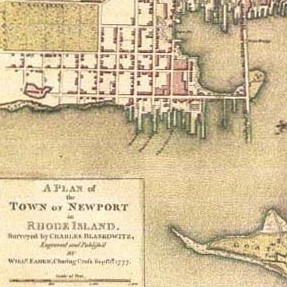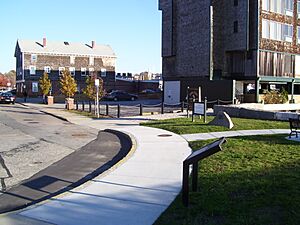Easton's Point facts for kids
The Point (or "Easton's Point") is one of the oldest neighborhoods in Newport, Rhode Island. It has many colonial houses, more than almost anywhere else in the United States. This neighborhood is located between Washington Street and Farewell Street/America's Cup in Newport. It looks out towards Goat Island, which used to be home to the U.S. Naval Torpedo Station.
Contents
Discover The Point: Newport's Historic Neighborhood
A Look Back: The Point's Early Days
Nicholas Easton, who helped found Newport, first settled in this area in the 1600s. In 1725, Easton's family divided his land into smaller pieces. They sold these pieces to many of Newport's first tradesmen and merchants. Many early residents went to the nearby Quaker Meeting House or Touro Synagogue.
Because of a Quaker tradition, none of the streets were named after people at first. So, 1st (now Washington), 2nd, and 3rd Streets were crossed by streets named after trees. These included Elm, Poplar, Willow, Walnut, Chestnut, Cherry, Pine, Sycamore, and Cypress. Marsh Street used to be a marsh, and Bridge Street had a bridge over the north side of that marsh. Long Wharf stretched across the south side of the marsh until the marsh was filled in during the 1800s.
In 1723, a place called Gravelly Point (off of Long Wharf) was where 26 pirates were executed. After this, they were buried on nearby Goat Island.
Famous Furniture Makers and Forts
During the American Revolution, around the time of the Battle of Rhode Island, British and French soldiers used various houses in "The Point." The famous Goddard and Townsend furniture makers lived and worked in The Point. Their houses are still standing today.
Battery Park was created from Fort Greene. This was a military fort from the War of 1812. It was built on the site of an even older fort from the American Revolution.
Bringing The Point Back to Life
Newport did not become a big industrial city. Because of this, many of its old colonial houses were not torn down. This happened in other cities like Boston and New York. So, Newport is believed to have the most colonial homes of any American city.
However, by the 1950s, The Point was largely overlooked and remained a working-class area. In the 1960s and 1970s, Doris Duke's Newport Restoration Foundation bought 27 historic houses in The Point. They fixed them up and now rent them out. In the 1960s, the building of the Newport Bridge split the neighborhood into two parts.
The Point is home to the Hunter House museum, the Rumbline Restaurant, and Saint John the Evangelist Anglican-Catholic Church. The old docks at the end of the streets are gone now. But the "driftways" (public paths) remained. These paths still allow people to access the harbor for boating.
Images for kids
-
The Newport Harbor Light (built 1842) on the northern tip of Goat Island, with the Newport Bridge in the background.
-
The Hunter House museum.
-
Saint John the Evangelist Church (Anglican) on Washington Street.














